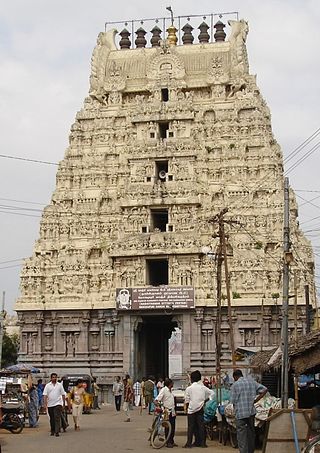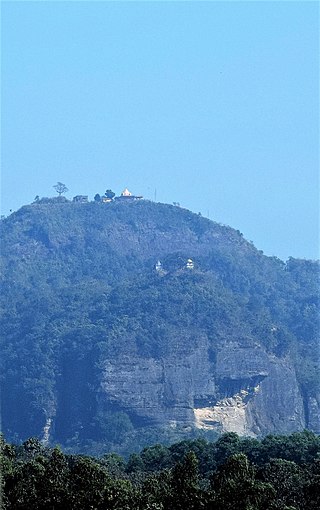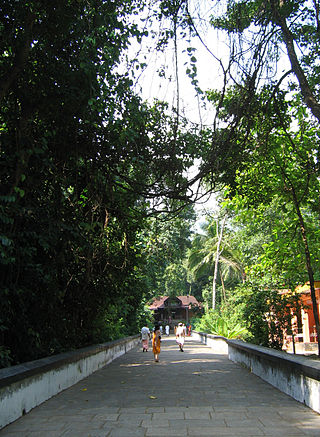
Sati, also known as Dakshayani, is the Hindu goddess of marital felicity and longevity, and is worshipped as an aspect of the mother goddess Shakti. Sati was the first wife of Shiva, the other being Parvati, who was Sati's reincarnation after her death.

The Shakti Pitha or the Shakti Peethas are significant shrines and pilgrimage destinations in Shaktism, the goddess-centric denomination in Hinduism. The shrines are dedicated to various forms of Adi Shakti. Various Puranas such as Srimad Devi Bhagavatam state the existence of varying number of 51, 52, 64 and 108 Shakti peethas of which 18 are named as Astadasha Maha (major) in medieval Hindu texts.

Mahur or Mahurgad is a town and religious place in Nanded district of Maharashtra, India. Mahur is the birthplace of Hindu God Dattatreya. Dattatreya parents Atri Rishi and Sati Anasuya Mata lived here. Brahmadev, Vishnudev and Lord Shiva once got a news about Anusaya Mata that there is no one more pious and pure as her. To test her piousness they arrived under the garb of asking Alm (bhiksha). Near Mahur, There is a Pious confluence of River Penganga and River Pus at Hiwara Sangam village, Tal. Mahagaon Vidarbha, from where the river flows northward. Penganga river forms a border between Vidarbha and Marathwada. Mahur falls just about 3kms inside Marathwada due to river banks.
Kalighat is a locality of Kolkata, in Kolkata district, West Bengal, India. One of the oldest neighbourhoods in South Kolkata, Kalighat is also densely populated — with a history of cultural intermingling with the various foreign incursions into the area over time.

The Kamatchi Amman Temple is an ancient Hindu Temple dedicated to the goddess Kamakshi, one of the highest aspects of Adi Shakti in Shaktism. It is located in the historic city of Kanchipuram, near Chennai, India. Its construction is credited to the Pallava kings, whose capital was in the same city. This temple, along with the Meenakshi Temple in Madurai and the Akilandeswari temple in Thiruvanaikaval near Tiruchirappalli are the important centers of Goddess worship in the state of Tamil Nadu.The present temple with goddess seated in padmasana was once known as Kaamakotta Nayaki shrine, where Lalitha Tripura Sundari has settled in this temple after the destruction of the demon called Bhandasura. This ancient temple got mentioned in Perunaraatrupadai, an ancient Tamil sangam literature which praises the renowned sangam era king Thondaiman Ilanthiraiyan who ruled whole Thondai mandalam during sangam era with Kanchipuram as capital city. The original golden statue was seen with two hands adorning a parrot in her right hand is called as Bhangaru Kamakshi was replaced with the current panchaloha idol to avoid ruins of invasion. Now the golden goddess is residing in the West masi veedhi of Tanjavore with aseparate shrine, as escorted by Shyama Shastri.

Jawalamukhi, or Jwalamukhialso Jawalaji, is a temple town and a nagar parishad in Kangra district in the Indian state of Himachal Pradesh. Hindu genealogy registers are kept here like that of Haridwar. The town takes its name from the holy Jwalamukhi Temple, located in Jawalamukhi.

Tripura Sundari Temple is a Hindu temple of the Goddess Tripura Sundari, better known locally as Devi Tripureshwari. The temple is situated in the ancient city of Udaipur, about 55 km from Agartala, Tripura and can be reached by train and road from Agartala. It is believed to be one of the holiest Hindu shrines in this part of the country and witnesses the highest number of visitors for a temple in North-East India, after Kamakhya Temple in Assam. The state of Tripura is named after this temple. Popularly known as Matabari, the shrine is set upon a small hillock that resembles the hump of a tortoise (Kurma). This shape called Kurmapṛṣṭhākṛti is considered the holiest possible site for a Shakti temple, hence also bestowing the name of Kurma Pīṭha. The Goddess is served by traditional Brahmin priests.

Tarapith is a 13-century Hindu temple in Chandipur village Rampurhat II CD block in Rampurhat subdivision of Birbhum district of the Indian state of West Bengal, known for its Tantric temple and its adjoining cremation grounds where sādhanā are performed. The Tantric Hindu temple is dedicated to the goddess Tara, a fearsome Tantric aspect of the Devi, the chief temples of Shaktism. Tarapith derives its name from its association as the most important centre of Tara worship.

Chintpurni is a small town in the Una district of Himachal Pradesh about 40 km north of Una, not far from the border with the Indian state of Punjab. The elevation is about 977 meters. It is home to the Maa Chintpurni Temple which is a major pilgrimage site as one of the Shakti Peethas in India. The Hindu genealogy registers at Chintpurni, Himachal Pradesh are kept here. North of Chintpurni are the western Himalayas. Chintpurni lies within the much lower Shiwalik range.

Guhyeshwari Temple, also spelled Guheswari or Guhjeshwari, is one of the revered holy temples in Kathmandu, Nepal. This temple is dedicated to Guhyeshwari or Adi Shakti. The temple is also a Shakti Peetha and it's about 1 km east of Pashupatinath Temple and is located on the southern bank of the Bagmati River. It is said that this temple is the Shakti chair of Pashupatinath Temple. It is an important pilgrimage destination for Hindus, especially for Tantric worshipers. King Pratap Malla renovated this temple in the 17th century. The goddess is also called Guhyekali.

Kalighat Kali Temple is a Hindu temple in Kalighat, Kolkata, West Bengal, India dedicated to the Hindu goddess Kali. It is one of the Shakti Peethas.

Jeshoreshwari Kali Temple is a famous Hindu temple in Bangladesh, dedicated to the goddess Kali. The temple is located in Ishwaripur, a village in Shyamnagar upazila of Satkhira. The name "Jeshoreshwari" means "Goddess of Jeshore".

Tara Tarini Temple is a famous Hindu shrine of Adi Shakti on Kumari hills at the bank of river Rushikulya near Purushottampur in Ganjam district of Odisha. Maa Tara Tarini is worshiped as the Breast Shrine of Adi Shakti Sati Devi here. The temple is one of the oldest pilgrimage centers of Mother goddesses and one of the four major Shakti Peethas and Tantra Peethas of India.

Chandranath Temple, located on top of the Chandranath Hill, is a famous Shakti Peeth located near Sitakunda in Bangladesh where, as per Hindu sacred texts, the right arm of Goddess Sati fell. Chandranath Temple is a pilgrimage site for Hindus. Its height about 1,020 feet (310 m) above sea level.

Kankalitala is a temple town in Bolpur Sriniketan CD block in Bolpur subdivision of Birbhum district in the Indian state of West Bengal.

Manikarnika Ghat is one of the holiest cremation grounds among the sacred riverfronts (ghats), alongside the river Ganges, in the city of Varanasi in the Indian state of Uttar Pradesh. In Hinduism, death is considered a gateway to another life marked by the result of one's karma. It is believed that a human's soul attains moksha, and hence breaks the cycle of rebirth when cremated here. Thus, scores of the elderly across the whole country seek to walk up to its edges, and spend their last days absorbing the charisma of the ghat making death painless and insignificant to be pondered upon.

Chandika Sthan is a Hindu temple situated in Munger, in the India state of Bihar. It is one of the fifty-one Shakti Peethas, places of worship consecrated to the goddess Shakti. On the Northeast corner of Munger, Chandika Sthan is just two kilometers away from the Munger town. Being a Siddhi-Peetha, Chandika Sthan is considered to be one of the most sacred and sanctified temples, as important as the Kamakshya temple near Guwahati.

The temple of Attahas, also known as Fullora Attahas, is believed to be one of the 51 Shakti Peethas at which the body parts and jewelry of the Hindu goddess Shakti fell to Earth. The goddess is so large that the lower lip is about 15 to 18 feet wide. The temple is a site of Hindu pilgrimage throughout the year. December is a particularly popular time for visitors to picnic at the site.

Kottiyoor Ulsavam or Kottiyoor Vysakha Mahotsavam is a 27-day annual pilgrimage observed by Hindus commemorating the Mythology of Daksha Yaga. The pilgrimage is similar to the Kumbh Mela of Prayag, where ablutions are performed. The temple and grounds are also known as Dakshina Kasi.

Kottiyoor Temple is a prominent Shiva temple in Kottiyoor, Kannur, Kerala,India. Vadakkeshwaram Temple is the common name of the temple from ancient times, but some of the local people address the temple as Ikkare Kottiyoor as it is on the bank of the river close to the Kottiyoor village, to differentiate it from the shrine in the other side of the river. Thruchherumana Kshetram is also another name by which temple is known. The temple is a special category temple under Malabar Devaswom board.























